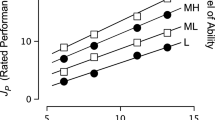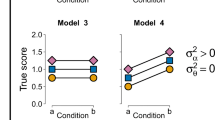Abstract
Within-subject designs (WSDs) remain unpopular in psychology. Social psychologists have argued that they create “demand” and “order” effects. Previous comparative studies conducted in the Information Integration Theory (IIT) framework have, however, shown that patterns of results observed using WSDs can largely be replicated using between-subject designs (BSDs). In order to add evidence to these findings, we conducted four additional studies to complement our data obtained in previous studies. Three of these studies tested three factorial plots of the appraisal of stimulus intensities resulting from a full factorial administration of stimulus components that are typically observed in IIT studies (a) parallelism only (adding), (b) parallelism plus cross-over (averaging), and (c) fan-shape open to the right (multiplying). The fourth study tested a non-linear shape factorial plot. Patterns observed in BSD and in WSD conditions were systematically compared. There was nothing in the results from the BSD studies that would contradict the conclusions drawn from the WSD studies. Advantages of WSDs over BSDs are that they are economical, they are statistically more powerful, the resulting patterns of data are less noisy (characterization of the information integration process is made straightforward), and more importantly, they facilitate analysis of individual differences in human judgment processes.





Similar content being viewed by others
References
Anderson, N.H.: Foundations of Information Integration Theory. Academic Press, New York (1981)
Anderson, N.H.: Methods of Information Integration Theory. Academic Press, New York (1982)
Anderson, N.H.: Contributions to Information Integration Theory. Lawrence Erlbaum Associates, New Jersey (1991)
Anderson, N.H.: A Functional Theory of Cognition. Lawrence Erlbaum Associates, New Jersey (1996)
Anderson, N.H.: Empirical Direction in Design and Analysis. Lawrence Erlbaum Associates, New Jersey (2001)
Anderson, N.H.: Unified Social Cognition. Psychology Press, New York (2008)
Anderson, N.H.: Methodology and statistics in single-subject experiments. In: Wixted, J. (ed.) Stevens’ Handbook of Experimental Psychology, vol. 4, pp. 301–337. Wiley, London (2002)
Anderson, N.H.: Information Integration Theory: unified psychology based on three mathematical laws. Univ. Psychol. Pan Am. J. Psychol. (2016). doi:10.11144/Javeriana.upsy15-3.iitu
Anderson, N.H.: Moral Science. Psychology Press, New York (2018)
Birnbaum, M.H.: How to show that 9 > 221: collect judgments in a between-subjects design. Psychol. Meth. 4, 243–249 (1999)
Birnbaum, M.H., Mellers, B.A.: Bayesian inference: combining base rates with opinions of sources who vary in credibility. J. Personal. Soc. Psychol. 45, 792–804 (1983)
Cosmides, L., Tooby, J.: Universal Minds. Weidenfeld and Nicolson, London (1999)
Falconi, A., Mullet, E.: Cognitive algebra of love through the adult life. Int. J. Aging Hum. Dev. 57, 277–292 (2003)
Gauché, M., Mullet, E.: Effect of context and personality on the forgiveness schema. Am. J. Psychol. 121, 607–617 (2008)
Girard, M., Mullet, E.: Forgiveness and its determinants in adolescents, adults, and elderly persons. J. Adult Dev. 4, 209–220 (1997)
Hofmans, J., Mullet, E.: Towards unveiling individual differences in different stages of information processing: a clustering-based approach. Qual. Quant. 47, 555–564 (2013)
Howe, E.S., Loftus, T.C.: Integration of intention and outcome information by students and circuit court judges: design economy and individual differences. J. Appl. Soc. Psychol. 22, 102–116 (1992)
Howe, E.S., Loftus, T.C.: Integration of certainty, severity, and celerity information in judged deterrence value: further evidence and methodological equivalence. J. Appl. Soc. Psychol. 26, 226–242 (1996)
Kahneman, D., Slovic, P., Tversky, A. (eds.): Judgment Under Uncertainty: Heuristics and Biases. Cambridge University Press, New York (1982)
Lautrey, J., Mullet, E., Paques, P.: Judgment of quantity and conservation of quantity: the area of the rectangle. J. Exp. Child Psychol. 47, 193–209 (1989)
Leon, M.: Integration of intent and consequence information in children’s moral judgments. In: Wilkening, F., Becker, J., Trabasso, T. (eds.) Information Integration by Children, pp. 71–97. Erlbaum, New Jersey (1980)
Léoni, V., Mullet, E.: Evolution in the intuitive mastery of the relationship between mass, volume, and density from nursery school to college. Gen. Soc. Gen. Psychol. Monogr. 119, 389–412 (1993)
McCrae, R.R., Costa Jr, P.T: Toward a new generation of personality theories: theoretical contexts for the five-factor model. In: Wiggins, J.S. (ed.) The Five-Factor Model of Personality: Theoretical Perspectives, pp. 51–87. Guilford, New York, NY (1996)
Morales, G.E., Lopez, E.O., Campos, C., Charles, D., Mezquita, Y.N., Mullet, E.: Conceptualization of love among adults with Down’s syndrome. Sex. Disabil. 33, 339–348 (2015)
Mullet, E., Cretenet, J., Dru, V.: Motor influences on judgment: motor and cognitive integration. Br. J. Psychol. 105, 69–91 (2014)
Mullet, E., Hofmans, J., Schlottmann, A.: Individual differences in information integration studies of children’s judgment/decision-making: combining group with single-subject design via cluster analysis. In: Toplak, M., Weller, J. (eds.) Individual Differences in Judgment and Decision Making: A Developmental Perspective, pp. 186–209. Psychology Press, New York (2016a)
Mullet, E., Kpanake, L., Kamble, S., Ahmed, R.A., Bugay, A., Muñoz Sastre, M.T., Sorum, P.C.: Mapping people’s views regarding physician assisted suicide: a five-country study. Int. Psychol. Bull. 20, 16–25 (2016b)
Mullet, E., López López, W., Kpanake, L., Mukashema, I., Armange, R., Kamble, S., Guedez, A.G., Pineda Marín, C., Muñoz Sastre, M.T., Sorum, P.C., Neto, F.: Functional measurement in the field of ethics in politics. Univ. Psychol. Pan Am. J. Psychol. (2016c). doi:10.11144/Javeriana.upsy15-3.fmf
Muñoz Sastre, M.T., Mullet, E., Sorum, P.C.: Self-assessment of inebriation from external indices. Addict. Behav. 25, 663–681 (2000)
Orne, M.T.: On the social psychology of the psychology experiment: with particular reference to demand characteristics and their implication. Am. Psychol. 17, 776–783 (1962)
Sorum, P.C., Stewart, T.R., Mullet, E., Gonzales Vallejo, C., Shim, J., Chasseigne, G., Muñoz Sastre, M.T., Grenier, B.: Does choosing a treatment depend on making a diagnosis? U.S. and French physicians’s decision making about acute otitis media. Med. Decis. Mak. 22, 394–402 (2002)
Sternberg, R.J.: Construct validation of a triangular love scale. Eur. J. Soc. Psychol. 27, 313–335 (1997)
Wilkening, F.: Combining of stimulus dimensions in children’s judgments of area: an information integration analysis. Dev. Psychol. 15, 25–33 (1979)
Author information
Authors and Affiliations
Corresponding author
Rights and permissions
About this article
Cite this article
Mullet, E., Chasseigne, G. Assessing information integration processes: a comparison of findings obtained with between-subjects designs versus within-subjects designs. Qual Quant 52, 1977–1988 (2018). https://doi.org/10.1007/s11135-017-0592-6
Published:
Issue Date:
DOI: https://doi.org/10.1007/s11135-017-0592-6




